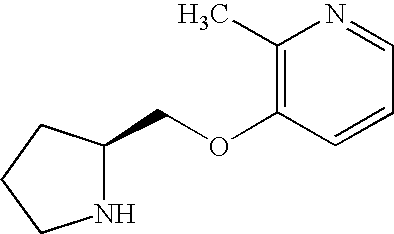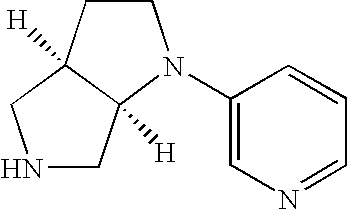Neuronal nicotinic receptor ligands and their use
a nicotinic receptor and neuronal technology, applied in the field of neuronicotinic receptor ligands, can solve the problems of limited therapeutic activity and not all the effects of certain nnr ligands are desirable, and achieve low incidence of nnr-mediated side effects, good tolerance, and cognitive benefits.
- Summary
- Abstract
- Description
- Claims
- Application Information
AI Technical Summary
Benefits of technology
Problems solved by technology
Method used
Image
Examples
example 1
[0062] Binding conditions were modified from the procedures described in Pabreza L A, Dhawan, S, Kellar K J, [3H]-Cytisine Binding to Nicotinic Cholinergic Receptors in Brain, Mol. Pharm. 39: 9-12, 1991. Membrane enriched fractions from rat brain minus cerebellum (ABS Inc., Wilmington, DE) were slowly thawed at 4° C., washed and resuspended in 30 volumes of BSS-Tris buffer (120 mM NaCl / 5 mM KCI / 2 mM CaCl2 / 2 mM MgCl2 / 50 mM Tris-Cl, pH 7.4, 4° C.). Samples containing 100-200 μg of protein and 0.75 nM [3H]-cytisine (30 Ci / mmol; Perkin Elmer / NEN Life Science Products, Boston, MA) were incubated in a final volume of 500 μL for 75 minutes at 4° C. Seven log-dilution concentrations of each compound were tested in duplicate. Non-specific binding was determined in the presence of 10 μM (−)-nicotine. Bound radioactivity was isolated by vacuum filtration onto prewetted glass fiber filter plates (Millipore, Bedford, MA) using a 96-well filtration apparatus (Packard I...
example 2
IMR-32 Assay
[0063] Cells of IMR-32 human neuroblastoma clonal cell line (ATCC, Rockville, Md., USA) were maintained in a log phase of growth according to established procedures. Experimental cells were seeded at a density of 500,000 cells / mL into a 24-well tissue culture dish. Plated cells were allowed to proliferate for at least 48 hours before loading with 2 μCi / mL of 86Rb+ (35 Ci / mmol) overnight at 37° C. The 86Rb+ efflux assays were performed according to previously published protocols (Lukas, R. J., J. Pharmacol. Exp. Ther., 265, 294-302, 1993) except serum-free Dulbecco's Modified Eagle's medium was used during the 86Rb+ loading, rinsing, and agonist-induced efflux steps. Data reflect the activation of 86Rb+ flux at a concentration of 1 μM, and reflect the response as a percentage of the maximum response elicited by (S)-nicotine. The data are interpreted such that the larger the response, the more potent is the activation of peripheral ganglionic receptors, which is further i...
example 3
[0064] A pilot study was designed to evaluate ABT-089, a neuronal nicotinic receptor (NNR) partial agonist, as treatment for adult attention-deficit hyperactivity disorder (ADHD). Method: Adults with ADHD received placebo, 2mg, 4mg, or 20mg of ABT-089 for two weeks each in a randomized, double blind, placebo-controlled 4×4 Latin square design for a total of 8 weeks. In addition to the primary outcome, the Conner's Adult ADHD Rating Scale (CAARS), secondary rating scales, neuropsychological, and safety assessments were completed. Results: A total of 11 adults with well-characterized ADHD completed this crossover study. ABT-089 was superior to placebo for the CAARS Total Symptom Score, which was the primary endpoint (placebo: 38.0±−1.9; 2 mg bid: 32.2±−1.9, one-tail p=0.021; 4 mg bid: 33.2±−1.9, p=0.047; 20 mg bid: 33.5±−1.9, p=0.056). ABT-089 was also superior to placebo for the CAARS ADHD index and Hyperactive / Impulsive scores and the Clinical Global Impression-ADHD Severity score. ...
PUM
| Property | Measurement | Unit |
|---|---|---|
| Fraction | aaaaa | aaaaa |
| Molar density | aaaaa | aaaaa |
| Mass | aaaaa | aaaaa |
Abstract
Description
Claims
Application Information
 Login to View More
Login to View More - R&D
- Intellectual Property
- Life Sciences
- Materials
- Tech Scout
- Unparalleled Data Quality
- Higher Quality Content
- 60% Fewer Hallucinations
Browse by: Latest US Patents, China's latest patents, Technical Efficacy Thesaurus, Application Domain, Technology Topic, Popular Technical Reports.
© 2025 PatSnap. All rights reserved.Legal|Privacy policy|Modern Slavery Act Transparency Statement|Sitemap|About US| Contact US: help@patsnap.com



